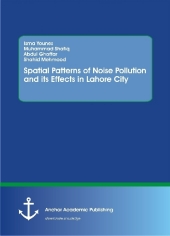 Neuerscheinungen 2017Stand: 2020-02-01 |
Schnellsuche
ISBN/Stichwort/Autor
|
Herderstraße 10
10625 Berlin
Tel.: 030 315 714 16
Fax 030 315 714 14
info@buchspektrum.de |

Abdul Ghaffar, Muhammad Shafiq, Isma Younes
(Beteiligte)
Spatial Patterns of Noise Pollution and its Effects in Lahore City
2017. 116 S. 35 Abb. 270 mm
Verlag/Jahr: ANCHOR ACADEMIC PUBLISHING 2017
ISBN: 3-9606713-9-3 (3960671393)
Neue ISBN: 978-3-9606713-9-8 (9783960671398)
Preis und Lieferzeit: Bitte klicken
Lahore is one of the cities most effected by uncontrolled noise pollution in Pakistan. The most important factor of noise pollution is the road traffic. The main objective of this study was to analyze and evaluate road traffic noise and to measure its effects on the population of Lahore city. A weighting sound level meter was used in the study. All the measurements were taken at a height of about 1.2 m from the ground at 56 sample sites. The spatial noise pattern was shown in maps. These were also drawn to show buffers dividing areas into moderate, high and extremely high risk zones in accordance with noise risk levels. The maps were additionally divided in day and night time maps, each with graduated symbols. The main day-night values were exceeding the permissible environmental standards used in Pakistan. Therefore, a survey was conducted to study the diseases caused by noise pollution in the areas with highest noise levels.
Text Sample:
Chapter 3: Noise pollution and its effects:
3.1 Introduction:
The term noise has been derived from a Latin word nausea meaning sea sickness (Singal, 2005), implying unwanted sound (Encyclopedia Americana) or sound that is loud, unpleasant or unexpected (Katyal, 1989), get dumped into the atmosphere without regarding to the adverse effects it may be having (Chhatwal, 1989). Psychologically, noise is just any sound undesirable by the recipient and may adversely affect the health and well-being of individuals or populations. It is wrong sound, in a wrong place, at the wrong time (Singal, 2005).
The extent to which noise contribute to the deterioration of our environment cannot easily be determined as that of pollution from other sources. Different people are not equally affected by noise pollution. There are different factors which have direct influence on the listener while considering a sound to constitute noise such as time, place and mood of the listener is also important. At one time and place the sound produced by one instrument may be noise for an individual but may be a rhythmic sound for another. If an individual feels happy he may not think a sound of a high intensity as noise but if one feels sad, may take that much intensity of sound as noise (Kupchella, 1993).
If we treat sound as an auditory sensation produced by these vibrating bodies, it gets characterized by its pitch, loudness and tone quality. These characteristics cannot be measured because they have been psychological sensations and depend upon the ear and judgment of the individual observer. In physical terms, sound may be defined as a fluctuation in pressure in an elastic medium, which give rise to the objective characteristics of sound such as frequency, intensity and wave form.
3.2 Measurement of noise:
The simplest method of noise measurement consists of assessing linear sound pressure level (SPL) at any time, disregarding variations with time, over a broad frequency band covering the whole of the audible frequency range (Singal, 2005).
3.3 Unit and range of noise:
Sound is measured by several complex systems, but the best known unit of measurement is the decibel (dB), a unit named after Sir Alfred Bell. The decibel is a tenth of the largest unit, the bel.
One decibel is equivalent to the faintest sound that can be heard by human ear. Frequency of the sound is defined as the number of vibrations per second. People can hear sound from 16-20,000 Hertz, but this range is reduced with age and other subjective factors (Katyal, 1989).
The range of vibrations below 16 Hz are infra-audible and those above 20,000 Hz are ultrasonic (Kumar, 1999). Some persons can hear frequencies that others are not able to detect. Many animals can hear sounds inaudible to human ear.
Human ear is known to be sensitive to extremely wide range intensity from 0 to 180 dB. While 0 dB is the threshold of hearing and 140 is the threshold of pain. Some people feel discomfort even with sound of 85 dB. Sound pressure level is a measure of air vibration that makes up sound [...].
3.4 Sources of noise pollution:
There are three sources of sound by category. These are Point Source, Linear Source and Plane Source.
3.4.1 Point source:
A sound source can be considered as a point source, if its dimensions are small in relation to the distance to the receiver and it radiates an equal amount of energy in all directions. Such point sources are industrial plants, aircrafts and individual road vehicles. The sound pressure level deceases 6 dB whenever the distance to a point source is doubled.
3.4.2 Line source:
A line source may be continuous radiation, such as from a pipe carrying a turbulent fluid, or may be composed of a large number of point sources so closely spaced that their emission may be considered as emanating from a line connecting them. The sound pressure level decreases 3dB, whenever the distance to a line source is doubled.
3.4.3 Plane source:
A plane so


